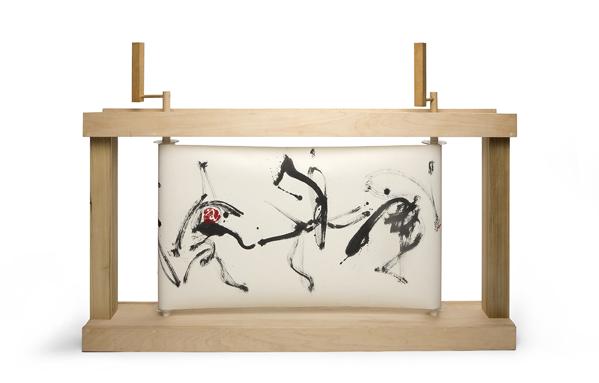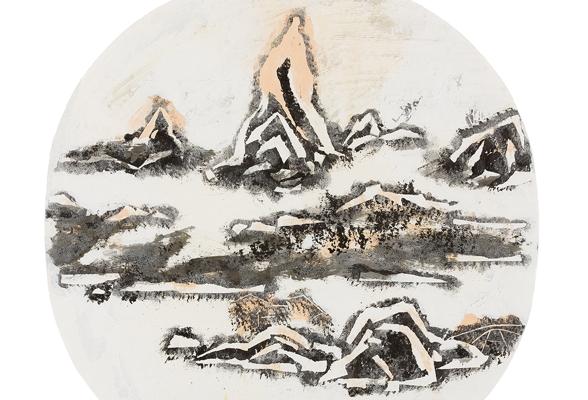
Ross Lewis’ work Scroll Machine is on display at his show in Beijing.[Photo/China Daily]
American painter Ross Lewis’ ongoing exhibition in Beijing tells the story of how Chinese cultural influences have shaped his work.
Lewis, who’s in his 50s, has drawn inspiration from shanshui (Chinese landscape ink art) since the 1980s. He has created dozens of attractive rope paintings as tributes to ancient Chinese landscape masters.
Lewis has marched further to present an effect similar to that of printing on paper.
“My study of Chinese calligraphy and landscape painting has influenced my perception of space and movement-the cornerstones of my work,” the New York-based artist says on the sidelines of his show, Dancing with Rope, at Beijing’s Today Art Museum.
Lewis calls himself “part Chinese” because of the dominant presence of Chinese culture in his career and personal life.

Eight Views: Pink Mountain features the influence of Chinese ink painting on US artist Ross Lewis.[Photo/China Daily]
His interest in Chinese culture grew from high school, and he studied Chinese literature and history at Oberlin College in the United States. He advanced his Chinese studies in Taiwan as an exchange student.
During his stay in Taiwan, Lewis got to know some veteran painters who became his mentors in the shanshui genre. After his graduation from Oberlin, he visited the Chinese mainland as a tour guide and met with more well-established artists, such as Lu Yanshao, Cheng Shifa and Zhu Qizhan.
The meetings deepened his understanding of Chinese art philosophy.
Lewis later became a curator at New York’s Hammerquist Gallery, where he promoted Chinese art through exhibitions and lectures.
By the ‘90s, he started to invest more energy in searching for his own style. His initial breakthrough is visible through his Shan-zi series that’s on display in Beijing.
He was inspired by the ancient landscapes created on a round piece of paper. But he felt no desire to just re-create the lines of masters. Lewis simply altered the traditional approach.
In his series, he applied masking tape on one side of hemp paper to create the impression of mountains and trees. He then dabbed acrylic paint on both sides of the paper and finally removed the pieces of tape. It resulted in a velvet-like feel while retaining the tranquillity of a classical masterpiece.
Lewis shows an even bolder attitude in the rope paintings that he has devoted his recent years to. In them, he replaced the brush with rope to work on thick paper, which is usually used for watercolor. Also, he has added the techniques of collage and tearing to share his personal memories and illusions with viewers.
Visitors to the exhibition should take a close look at Lewis’ inked ropes to understand how his artworks were created. The painter uses ropes of various textures, made of different materials. Underlying his rope paintings is the time-consuming process in which Lewis saturated different ropes and scraped them on the paper to test the effects.
Shen Kuiyi, the exhibition’s curator, says Lewis’ innovative approach has given the shanshui genre a modern interpretation.
“The intersection of concrete images and abstract lines in his works, together with the drama of unexpected perspectives, creates a strongly contemporary feeling,” Shen says.
“The rope art has opened a chapter in his artistic exploration, in which he is able to balance between perfection and incompleteness.”
To Lewis, art is what “one lives for”.
“When we have accumulated knowledge of and feelings for art, we don’t have to listen to someone else, but our hearts,” the artist says.
If you go
10 am-6 pm, through Aug 4. Today Art Museum, Building 4, Pingod Community, 32 Baiziwan Road, Chaoyang district, Beijing. 010-5876-0600.
